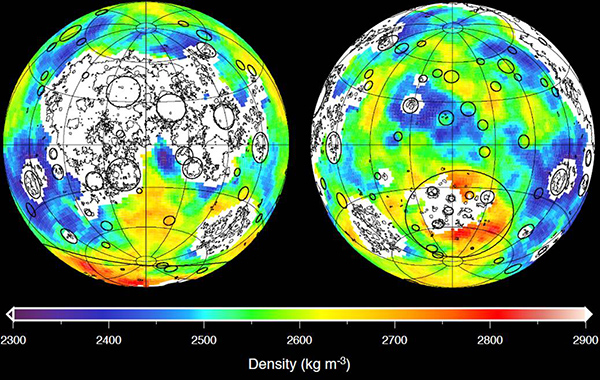
by Sean Treacy Thursday, December 6, 2012

This graphic shows the density of the lunar highlands on the near and far sides of the moon as generated using gravity data from NASA's GRAIL mission and topography data from NASA's Lunar Reconnaissance Orbiter. Red corresponds to higher than average densities and blue to lower than average densities; white corresponds to basalt.
SAN FRANCISCO: The face of the moon has always enchanted humankind, but new data from a NASA mission have given scientists a glimpse of what lies beneath the surface. A new, highly detailed map of the moon’s gravity has revealed evidence of underground cracks created by its hot, molten center as it came into shape billions of years ago, a team of scientists announced today at the annual meeting of the American Geophysical Union in San Francisco.
Two spacecraft, called Ebb and Flow, that are part of NASA’s GRAIL mission spent months earlier this year sensing the lunar gravity. They manage this by sending signals back and forth while they sail in orbit around the moon. By calculating how much the distance between the two spacecraft changes, researchers can see small variations in the moon’s gravity, and thus its mass, across its surface. The result is a detailed map of the moon’s gravity, which they unveiled today.
About 98 percent of the gravity variations GRAIL detected comes from structures visible on the lunar landscape, such as the craters and mountains. But the remaining 2 percent of the data from beneath the lunar surface produced something researchers weren’t expecting: gravitational anomalies, or spikes in the gravitational pull, that litter the lunar underground. These anomalies, which can stretch as long as several hundred kilometers, help show how the moon formed in its first billion years, said Jeff Andrews-Hanna, a planetary scientist with the Colorado School of Mines, at a press conference.
These results, along with two other studies detailing findings from the GRAIL mission, are slated to appear in the journal Science.
The gravity anomalies come from dikes — stretches of volcanic rock that formed when magma from the moon’s interior expanded and pushed against the moon’s cooler crust, filling the resulting cracks, Andrews-Hanna said. “For the past 3.5 billion years, the moon has been gradually cooling down and contracting, but we’re saying that the first billion years, it was warming up and expanding,” he said.
The research also shows that the dikes are much older than the cratered crust of the moon. One dike on the far side of the moon stretches almost 500 kilometers underground in a nearly straight line, even though the surface is covered with craters. “What that’s telling us is that that gravity anomaly formed before the majority of the craters on the moon. So it’s a very ancient structure,” Andrews-Hanna said.
This new evidence supports the idea that a huge impact with the early Earth knocked debris into orbit that collected to form what we know today as our moon. Although scientists have long theorized this, GRAIL provided the first evidence of that formation process that scientists can directly observe, Andrews-Hanna said.
The gravity map also revealed details about the moon’s crust.The data showed that the moon’s crust was an average of 34 to 43 kilometers thick, about 10 to 20 kilometers less than estimates derived from previous missions. That revelation about the moon’s crust is a sign that the moon has the same aluminum content that Earth has, which is another sign that the moon is made with the stuff of the Earth.
Visit NASA to see a video tour of the gravity anomalies of the moon.
© 2008-2021. All rights reserved. Any copying, redistribution or retransmission of any of the contents of this service without the expressed written permission of the American Geosciences Institute is expressly prohibited. Click here for all copyright requests.